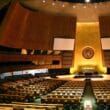Banning hypersonics: Too much to hope for
By Tong Zhao, June 26, 2015
If relationships between weaker and stronger nuclear weapon states are to remain stable, mutual assured destruction must be maintained in a robust, credible way. But nations' faith in the survivability of their nuclear deterrents could be seriously undermined by hypersonic missiles—either boost-glide systems or hypersonic cruise missiles—armed with conventional warheads. Some analysts in China suspect that the United States is seeking the ability to eliminate Beijing's nuclear deterrent in a first strike—and if Washington successfully develops hypersonic missiles, Beijing’s confidence in the credibility of its nuclear deterrent would only erode. (In a similar vein, Delhi might someday grow concerned about a Chinese hypersonic strike against India’s small nuclear arsenal.)
Already, some in China are discussing whether Beijing should, in the face of new conventional threats to its nuclear arsenal, alter its unconditional no-first-use policy. And a lack of understanding regarding future hypersonic missile policy has already begun to complicate strategic security dialogue between China and the United States—and between the United States and Russia. These countries' deeply-rooted mutual mistrust makes it inevitable that, if one nation deploys hypersonic missiles, another nation will perceive the threat in an exaggerated manner. Nations concerned about the survivability of their deterrents might build additional nuclear facilities deep underground—or begin to demonstrate less transparency about their nuclear policies. Such developments would hobble efforts to build confidence between national military establishments. Dialogue may help allay concerns—but only to a limited extent.
The greatest advantage of hypersonic missiles is their promptness, but promptness is also the technology's greatest source of risk. Decision makers in a crisis, if they wish to take advantage of hypersonic missiles' speed, will have to decide whether to launch preemptive strikes before fleeting windows of opportunity close. Risky decision making would be encouraged. And because hypersonic missiles would likely be intended for use against strategic targets—command and control centers, long-range surveillance systems, and even missile launch vehicles—conflicts could easily escalate if hypersonic missiles were used.
Tough obstacles. But can nations avoid a costly, technology-driven, hypersonic arms race by embracing preventive arms control? The prospects don't look very encouraging.
First, imposing technical limits on programs for hypersonic missile development would be difficult. No clear technical distinction can be made between hypersonic missiles and other conventional capabilities that are less prompt, have shorter ranges, and also have the potential to undermine nuclear deterrence. Nations would find it quite difficult to draw lines controlling the different technologies. Moreover, one possible US objective in developing hypersonic missiles is to gain the ability to preemptively strike small nuclear arsenals such as North Korea's—as opposed to, say, China's. But North Korea's nuclear and missile capabilities have been advancing quickly. By the time hypersonic technology is deployed, it may not be possible to structure US hypersonic capabilities in such a way that North Korea's nuclear weapons could be threatened but China's could not. And even if it were possible—through diplomatic arrangements or unilateral restraint—to keep US hypersonic capabilities limited to a small scale, Russia and China would remain concerned about the chance of future expansion.
Second, hypersonic systems are not necessarily intended only for delivering conventional weapons. Some nuclear weapon states, concerned about future advances in missile defense, are retaining the option of mounting nuclear warheads on boost-glide vehicles or hypersonic cruise missiles. Highly maneuverable systems such as these could significantly increase nuclear warheads' ability to penetrate midcourse missile defense. The stakes in developing hypersonic missiles are therefore high—higher than would surround the development of a new, purely conventional capability. So nations may be very reluctant to renounce hypersonic missiles.
Third, even though Washington may not be developing hypersonic missiles in order to target the nuclear arsenals of other major nuclear powers, some US analysts express interest in targeting such countries' non-nuclear strategic targets. Hypersonic missiles could become part of so-called "defense suppression" operations that would seek to counter the "anti-access/area denial" capabilities of China and others. Antisatellite assets could also become targets.
At a time such as this, when tensions between some of the major investors in hypersonic technologies appear to be rising, severe challenges face efforts to control such technologies. Increasing friction in the South China Sea is just one example of US-Chinese military tension in the Asia-Pacific region. In Eastern Europe, NATO and Russia appear headed toward a more hostile conventional military relationship. In such circumstances, national leaders are usually more interested in investing in new military technologies than in controlling them—especially technologies that may hold the key to prevailing on future battlefields.
Achievable steps. Given all this, banning research and development programs for hypersonic missiles will be difficult. Limited transparency measures, such as data exchanges and notifications, might be within reach—but even these mechanisms will require persistent effort and engagement from the major players.
In the short term, the best that can realistically be achieved might be unilateral risk reduction measures (backed up by diplomatic efforts that build confidence in these measures). For example, nuclear weapon states should for their own benefit refrain from developing strategies that involve using hypersonic missiles against nuclear targets. The 2013 US National Defense Authorization Act required the Defense Department to conduct a study on Washington's capability to "neutralize" Chinese underground networks, where some nuclear weapons are deployed, with "conventional and nuclear forces." Such a study suggests an actual interest in targeting nuclear weapons through conventional means—but anything of this nature should be scrupulously avoided.
Likewise, strategies that might exacerbate the "fog of war" should be carefully scrutinized. For instance, though preemptive strikes with hypersonic missiles against command, control, and communication centers might be a useful way to counter "anti-access/area denial" capabilities, they also risk "blinding" and confusing an adversary's leadership—to the extent that decision makers mistakenly believe a nuclear strike is under way. This would represent a serious risk of inadvertent escalation. Any strategy that blurs the line between conventional and nuclear warfare should be rejected. Nations deploying hypersonic weapons should vigorously pursue unilateral steps that will forestall destabilization—if in fact these technologies are going to be deployed at all.
Topics: Nuclear Weapons, Technology and Security
Share: [addthis tool="addthis_inline_share_toolbox"]














